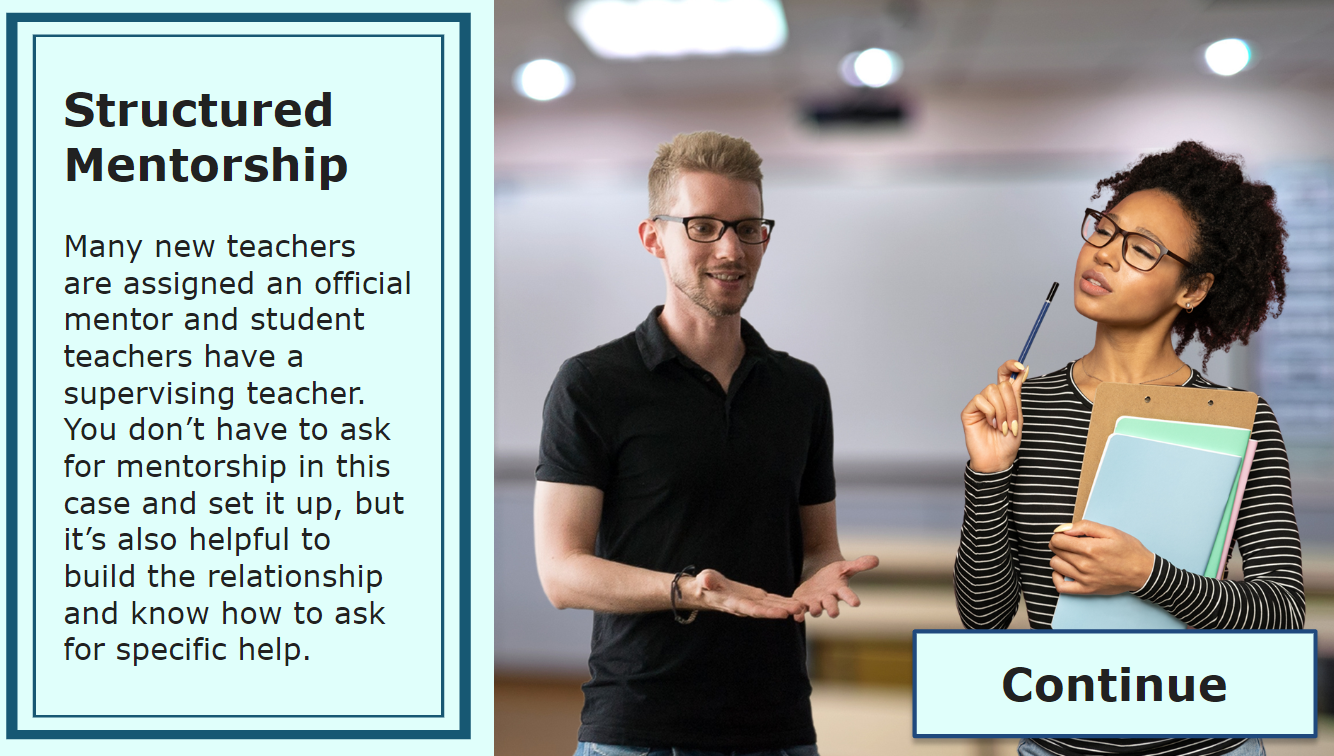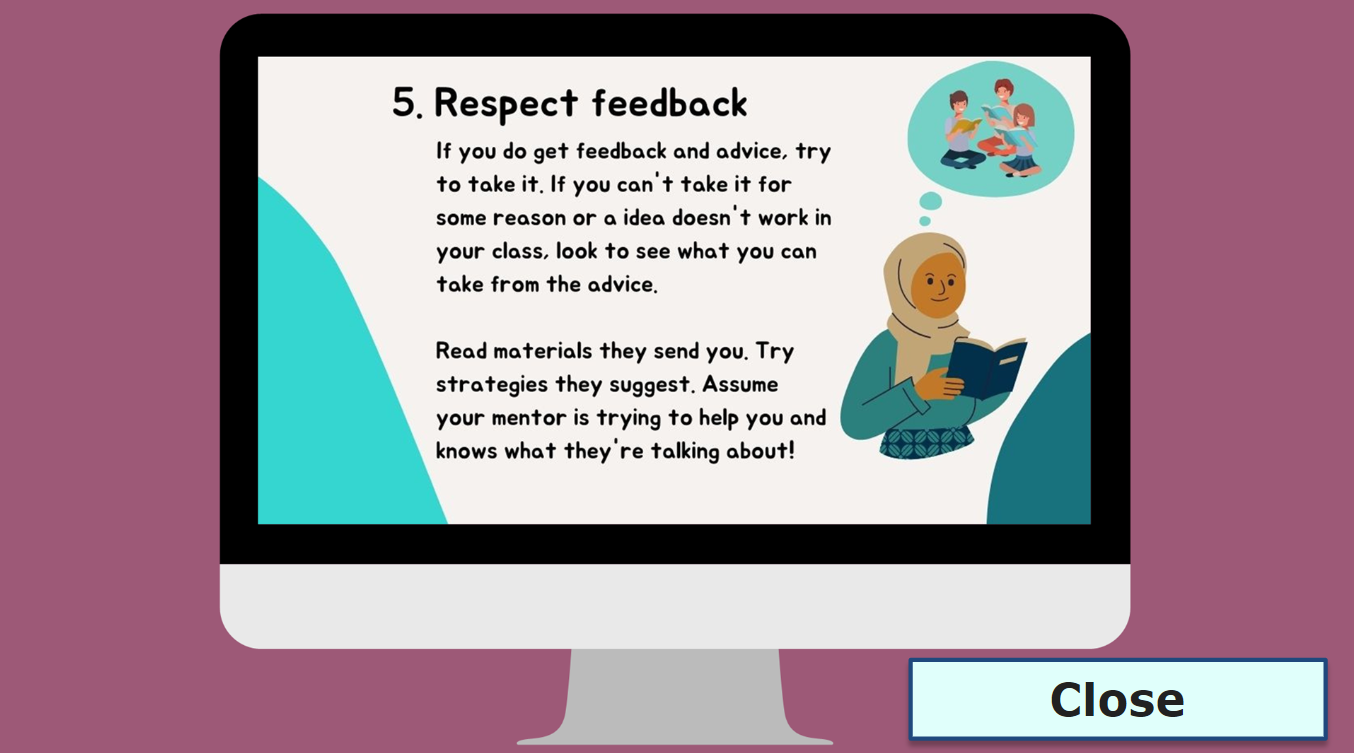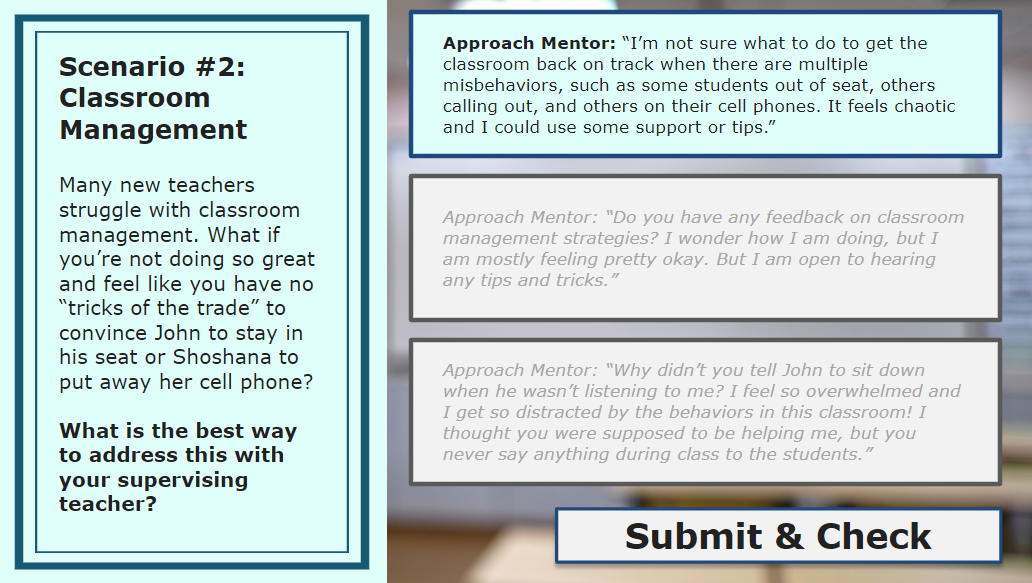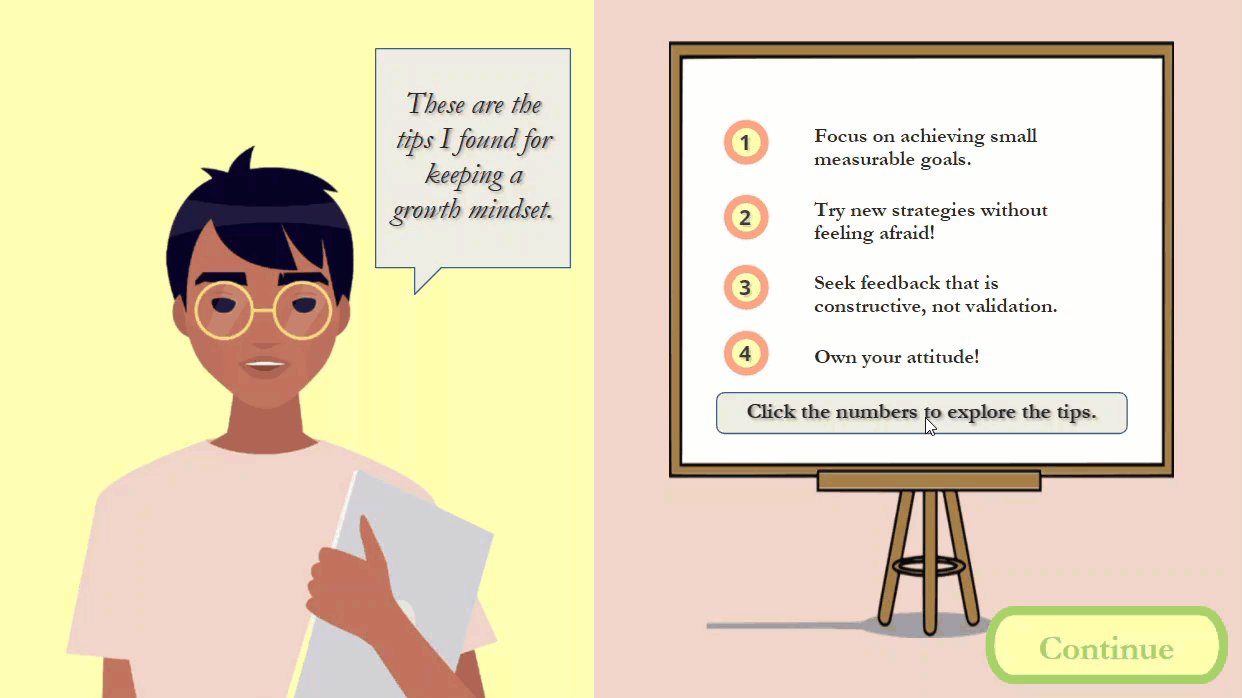This eLearning was developed with multiple assets and programs for Canvas LMS to support new teachers and student teachers particularly in seeking mentorship actively rather than passively. This was piloted with student teachers beginning in the 2021-22 school year.
Responsibilities: Project Management, Needs Analysis, Instructional Design, Storyboarding, Consensus Building with Stakeholders/SMEs, eLearning Design, Implementation for User Feedback, and Evaluation of User Feedback Data
Tools Used: Articulate Storyline, Canva, Adobe Photoshop, Adobe Illustrator, PowerPoint, Snipping Tool, Camtasia, Audacity, Canvas LMS, and Microsoft Project for Project Management
Storyline Functions Include: Triggers and variables to change the state of objects and remember state changes on later slides, freeform assessment questions, custom feedback slides, hotspots, custom buttons and navigation, text variables used for text entry for learners to compare their reflection to answer, media integration (audio and video), and accessibility including captions and focus order.
Date Completed: Last Updated February 2022
Scenario Based Learning: Student Teacher Orientation
About the Project
The Project Context: This project has a cluster of learning materials that are organized into Course 2 of a Canvas program for student teacher onboarding and orientation. This Module would precede the unique school-based orientation course that shared key resources for their specific school placement and follow the initial district onboarding course on following policies/procedures.
My Skills: This project shows my ability to identify needs and improve programs. Our student teachers struggle with self-advocacy and seeking mentorship, and this provided resources, mini scenarios, and direction on how to begin to build this important skill as a reflective educator. This also showcases how I work with others (stakeholders, SMEs) to build learning for wide-scale purpose.
How the Project Started: I wanted to do something “real use” in Storyline, a tool I had recently discovered. Though I had made staff training, I had never used a rapid authoring tool before, just LMS or video tools.
Before beginning the full length project, this started as a gap closure for student teachers prompted by discussions with clinical educators who mentored new and student teachers and administrators who worked with student teachers in their schools. I consulted with a professor from a nearby university who supervised 20-40 student teachers per year and developed a pilot for her to showcase to her student teachers. That storyboard was reviewed by subject matter experts from the university and district.
This learning experience includes the Storyline module, LMS activities in Canvas, preceptor/ mentor activities, and videos.
Design Process
Analysis Phase
In my district, I was a Clinical Educator (certified mentor teacher) who mentored new and student teachers, so I had some subject-matter expertise specific to this project, as well as experience on the committee for onboarding student teachers. This need was identified based on prior student teacher surveys and conversations with mentor teachers.
Learner Profile: The audience was primarily preservice or student teachers. However, since we had a large alternative certification program, it was determined thus could also be repurposed for that audience as well.
Problem/Solution: One piece of that puzzle that we identified and feel is rarely addressed for new teachers is the role of the teacher seeking mentorship, not just the role of mentors. Very rarely are guides or training focused on giving new teachers strategies to assert themselves and request mentorship or build a relationship with mentors. Even per teacher evaluation models such as Marzano, “seeking mentorship” is an essential skill for educators (Marzano, 2017). While the district has many options for mentorship available, new teachers and student teachers are not actively taught how to seek these resources. This guide focuses on scenario-based learning to showcase specific examples of effectively seeking mentorship. I also investigated formal and informal mentorship separately after one principal mentioned the distinction being a pain point for many new teachers. Data revealed other administrators and mentor teachers agreed.
Measurement Planning: This training would be considered a success based on questions from student teacher surveys at the end of their experience (Level 1), activities within the module assessed by their mentor teachers (Level 2), and observations from administrators at select school sites to use checklists for student teacher behaviors related to seeking mentorship (Level 3) to see if student teachers are successfully implementing the strategies and behaviors suggested. There was not clear outcome planning for Level 4 Kirkpatrick realization of full organizational goals because a “quality standard” and district organizational benefit for this could not be fully determined. However, we also determined to track in the pilot whether student teachers who piloted the new module were more likely to finish student teaching or work with the district after graduation.
Design & Development
Based on our content needs, I wrote and designed the storyboard in PowerPoint and shared with several SMEs collaboratively to discuss the effectiveness of the scenarios. Through rapid prototyping, I made changes to scenario details, visual clarity, interaction feedback, and I added the "Why seek mentoring" slide to clarify purpose for student teachers/new teachers who might have motivation or knowledge gaps on why mentoring is helpful. The Storyline sample shown came first, and additional needs on the topic were identified before the district lead suggested we develop it into a full module.
Design & Development Priorities:
Diverse Representation: In designing the learning and selecting assets, it was important to me even with free stock photos, to try and represent diverse humans in the final product. This was difficult because of our lack of resources in K12 education and the lack of diverse stock photos in some cases.
Clarity In User Feedback: The avatar mentors and student/new teacher was a particular design choice. I wanted to use the same student/new teacher throughout but different mentors. At first, I had the mentors change each scenario but that felt chaotic/confusing because of the way the feedback slides were designed so I kept the same avatar so that it could become a visual signal, along with the color change, text feedback, and sound “wrong/right” feedback.
Accessibility: I focused on configuring focus order and adding accessible text and alt-text to images, ensuring work with these new tools would still be district-accessible.
Implementation & Pilot
This module was designed for implementation in multiple schools through the district Learning Management System, Canvas.
Implementation took multiple phases. At first, this was a project that I designed to fit a need I have seen rather than one I was contracted to create. So, we did an informal pilot where a few student teachers and newer teachers reviewed an early version to get user feedback. Because they said it was helpful in the surveys given, we continued to full development and implementation. We had several pilot phases, first with user experience in the Storyline and then with the full course.
Iterations were made to the user feedback pilot and survey through March 2022. However, I handed off the project before the final evaluation as I left the district for my Learning Experience Designer job.
Evaluation
Pilot: Pilot evaluation examined user experience and further gap analysis to ensure the module met the needs of student teachers fully. Feedback was implemented in iterations.
Level 1: Do student teachers feel more confident in these skills? (per student teacher surveys)
Student teacher surveys to indicate effectiveness, usability, and relevance of the learning, as well as to gauge the impact on their confidence in seeking mentorship. Initial results suggested student teachers who completed this module felt “Very Confident” and all 100% were “Confident” or higher in the seeking mentorship skill listed. This compares with only 64% “Very Confident” and 76% “Confident” in the population of teachers who did not have this module.
Level 2: Are student teachers showing understanding of these behaviors during the module? (per assessments in course and with mentors)
Activities student teachers completed on the LMS checked by their mentors indicated full comprehension (100%) of the module. xAPI data from the Storyline indicated most learners (86%) selected the correct answers on the first try of the final check scenario after practicing.
Level 3: Are student teachers showing these behaviors with their mentors? (per administrator/clinical educator checklist evaluations and mentor surveys)
Mentors/clinical educators were given a checklist to report if student teachers were seeking formal and informal mentorship actively. (Evaluation was still in progress when I left the district.)
Level 4 could not be fully determined, but we hypothesized that if student teachers felt more confident seeking mentorship and practiced it more, learning the behavior during this period, they would feel more successful overall, be more likely to complete student teaching (which had a declining rate since 2019), and would be more likely to take jobs with the district after graduation. The kinds of questions we considered were:
Does this module increase the likelihood student teachers will complete their student teaching and take jobs with the district?
Does using this tool raise average first year effectiveness on the "Seeking mentorship" evaluation score received in iObservation?
Does this tool increase retention in Year 0 (the first year) of a teacher's career with the district? (Currently over 50% of Year 0 or first year teachers leave either their position or the district as a whole.)
Final Note: I developed and designed all of these materials, aside from the pilot I had permission for, with my own software, time, and assets, as well as with the full understanding I would be able to showcase this project. The district was given lifetime permission to use and adapt.
More Course Assets Developed
Based on the positive feedback from student teachers and collaboration with curriculum resource teachers and student teacher advisors that I worked with, I finished the LMS course on seeking out mentors as well as additional lessons and resources focused on:
Building and maintaining a growth mindset
Setting goals with mentors and developing SMART goals
Developing a reflective practice as a new teacher
These topics were selected based on the consensus of surveys and 15+ stakeholders and SMEs I brought together to review the analysis and pilot data.
This gif shows the linked Growth Mindset microlearning, also developed in Storyline and connected to activities in the LMS and with mentor teachers on growth mindset. You can experience it below:
The job aid above is embedded that supports a coaching activity student teachers do with their mentor teachers in the orientation process. Student teachers also have regular SMART goal meetings with their mentor teachers during the program and student teaching experience.
A version of the course stripped of district information is available on Canvas Commons under the title “Student Teacher Orientation: Seeking New Mentorship” and my name “Alison Sollars” if you wish to search it. As you must be logged in to find it, I cannot link directly.
The full course contains activities for student teachers to do independently and with mentor teachers, as a hybrid program.
Credits & Resources
Images in this project were sourced from paid subscriptions to Envato Elements and Canva, as well as Adobe free images.
Audio and video in this project were produced by me in properly licensed tools. I produced this with an understanding it would be published on this and future portfolios.
References
Callahan, J. (2016). Encouraging retention of new teachers through mentoring strategies. Delta Kappa Gamma Bulletin, 83(1), 6.
Marzano, R. J. (2017). The new art and science of teaching. Solution Tree Press.
Redding, Christopher. (2021, June 4). Teacher turnover is a problem – here's how to fix it. The Conversation. Retrieved January 22, 2022, from https://theconversation.com/teacher- turnover-is-a- problem-heres-how-to-fix-it-101584


















